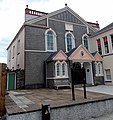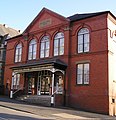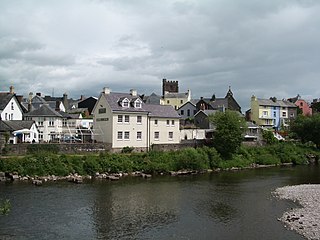
Brecon, archaically known as Brecknock, is a market town in Powys, mid Wales. In 1841, it had a population of 5,701. The population in 2001 was 7,901, increasing to 8,250 at the 2011 census. Historically it was the county town of Brecknockshire (Breconshire); although its role as such was eclipsed with the formation of the County of Powys, it remains an important local centre. Brecon is the third-largest town in Powys, after Newtown and Ystradgynlais. It lies north of the Brecon Beacons mountain range, but is just within the Brecon Beacons National Park.

Alfred Waterhouse was an English architect, particularly associated with Gothic Revival architecture, although he designed using other architectural styles as well. He is perhaps best known for his designs for Manchester Town Hall and the Natural History Museum in London. He designed other town halls, the Manchester Assize buildings—bombed in World War II—and the adjacent Strangeways Prison. He also designed several hospitals, the most architecturally interesting being the Royal Infirmary Liverpool and University College Hospital London. He was particularly active in designing buildings for universities, including both Oxford and Cambridge but also what became Liverpool, Manchester and Leeds universities. He designed many country houses, the most important being Eaton Hall in Cheshire. He designed several bank buildings and offices for insurance companies, most notably the Prudential Assurance Company. Although not a major church designer he produced several notable churches and chapels.
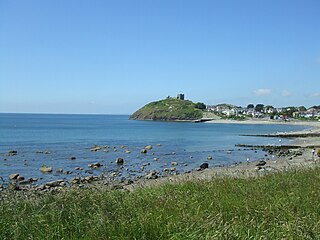
Criccieth, also spelled Cricieth ( ), is a town and community in Gwynedd, Wales, on the boundary between the Llŷn Peninsula and Eifionydd. The town is 5 miles (8 km) west of Porthmadog, 9 miles (14 km) east of Pwllheli and 17 miles (27 km) south of Caernarfon. It had a population of 1,826 in 2001, reducing to 1,753 at the 2011 census.
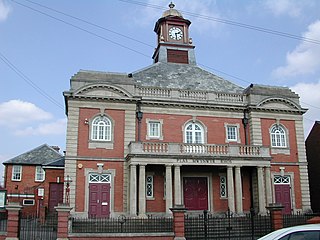
Rhosllanerchrugog is a village and community in Wrexham County Borough, Wales. It lies within the historic county of Denbighshire. The entire built-up area including Penycae, Ruabon and Cefn Mawr had a population of 25,362.

Chwilog is a village in Gwynedd, north Wales, and located on the Llŷn Peninsula. It is in the community of Llanystumdwy, near Criccieth, and in the medieval commote of Eifionydd, named after a 5th-century ruler. It is within the Dwyfor Meirionnydd constituency in the UK Parliament and in the Senedd. The name means 'abounding in beetles' and was perhaps transferred from an earlier name of the river.
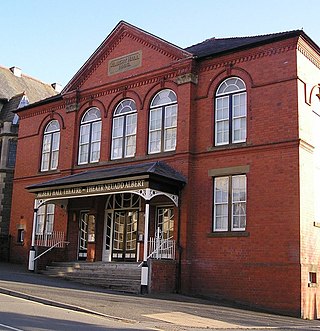
The Albert Hall is a period Victorian theatre and community venue in Llandrindod Wells in Powys, Wales. Originally built as a church hall in 1896, it became a theatre in 1922, with the addition of an art-deco foyer. The exterior of the building, foyer and auditorium remain to this day much as they were then.

St Alban's Church in Macclesfield, Cheshire, England, is a Roman Catholic parish church. The church is recorded in the National Heritage List for England as a designated Grade II* listed building. It was designed by A. W. N. Pugin and is described as a "church of exceptional interest among the works of this major architect".

The architecture of Liverpool is rooted in the city's development into a major port of the British Empire. It encompasses a variety of architectural styles of the past 300 years, while next to nothing remains of its medieval structures which would have dated back as far as the 13th century. Erected 1716–18, Bluecoat Chambers is supposed to be the oldest surviving building in central Liverpool.
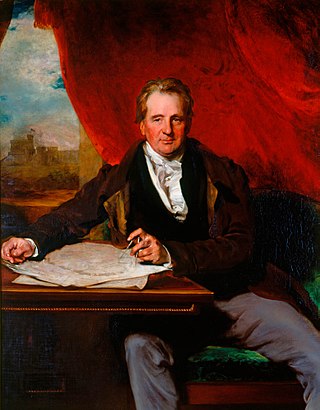
Sir Jeffry Wyatville was an English architect and garden designer. Born Jeffry Wyatt into an established dynasty of architects, in 1824 he was allowed by King George IV to change his surname to Wyatville. He is mainly remembered for making alterations and extensions to Chatsworth House and Windsor Castle.
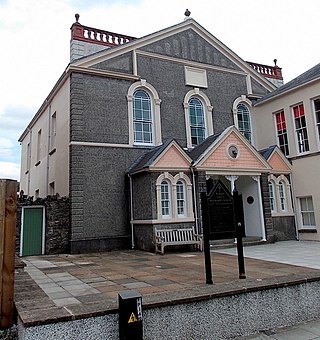
Plough Lane Chapel or Plough United Reformed Church is a historic building in Brecon, Wales. The chapel's foundation dates to the 17th century and the structure was rebuilt in 1841, then again in 1892. Cadw, the historic environment service of the Welsh Government, listed the chapel as a Grade II* historic building in 1976 for its "unusual porch" and "elaborate and fine interior".

Tabernacle is a Welsh-language Baptist chapel in The Hayes in the centre of Cardiff, Wales. It is a Grade II* listed building.

Architecture of Wales is an overview of architecture in Wales from the medieval period to the present day, excluding castles and fortifications, ecclesiastical architecture and industrial architecture. It covers the history of domestic, commercial, and administrative architecture.

Percy Richard Morley Horder was an English architect who early in his career worked from offices in Stroud and later in London. His early work was in the Arts and Crafts style, but after the First World War his buildings were increasingly in the Neo-Georgian fashion. His work included public houses for the Godsell Brewery and designing new country houses or partially rebuilding existing houses. He also designed country-house gardens and is noted for laying out Highfields Park, Nottingham together with the adjacent Nottingham University Campus. He undertook architectural work in many parts of the British Isles including Ireland. He is probably best remembered for the Trent Building in the University of Nottingham. and for design of the London School of Hygiene and Tropical Medicine. His work at Upton House, Warwickshire for Viscount Bearsted is notable, but it is his work for Jesse Boot, both the Boots the Chemists stores, but most importantly the Trent Building and the laying out the campuses of the University of Nottingham, which influenced design at other English universities, for which he must take the greatest credit.

Thomas Thomas was a Welsh church minister and chapel architect, also known as Thomas Glandŵr. He is described as "the first national architect of Wales" and the "unchallenged master of chapel architecture in Wales in the 1860s".

Capel Als is an Independent (Congregational) chapel in Llanelli, Carmarthenshire, Wales, It is regarded as one of the most significant religious buildings in Wales. Folk tradition suggested that the name refers to a woman named Als, which along with Alys is the Welsh equivalent of the English name Alice, whose cottage stood where the chapel was built. Another theory contends that the Welsh word als translates as rock, and there is a rock-face behind the chapel. However, there is no word "als" in Welsh meaning rock, and so this latter explanation may be safely disregarded.
Daniel John Davies was a Welsh Independent (Congregationalist) minister and Welsh language poet. He published under the name 'D.J. Davies' and was also well known as 'Davies Capel Als'.
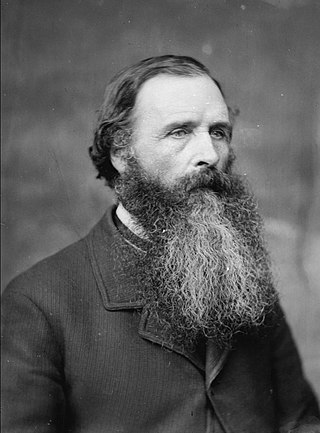
Richard Owens was a Welsh architect, working mostly on urban housing in Liverpool, England and on the construction of chapels in Wales.

William Owen (1791–1879) was a Welsh architect working in Haverfordwest in the late Georgian and early Victorian periods. He built up a considerable practice in Pembrokeshire and Carmathenshire. He was the county surveyor of Pembrokeshire, four times Mayor of Haverfordwest and High Sheriff of Pembrokeshire in 1859.



